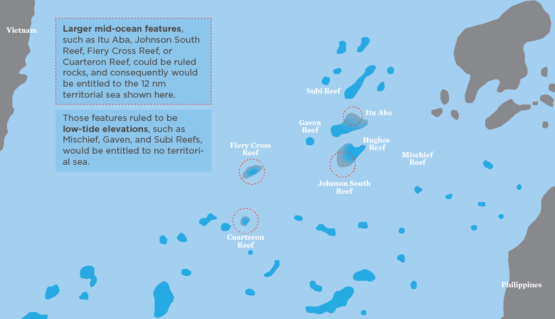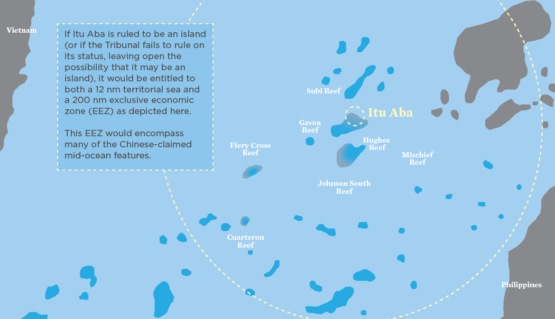April 14, 2016
Reefs, Rocks, and the Rule of Law
After the Arbitration in the South China Sea
This spring, the International Tribunal on the Law of the Sea under the Permanent Court of Arbitration at The Hague will issue a ruling in the case that has become known as Philippines v. China. The case, which was brought before the court in early 2013, will make headlines due to the significant spike in South China Sea tensions that has occurred since it began. It will also make history as perhaps the most ambitious and farthest-reaching case ever to have been heard pursuant to the Law of the Sea. The decision is likely to clarify several important issues at the heart of the South China Sea disputes as well as reduce the scope of the disputes. The tribunal will not, however, adjudicate questions of sovereignty – indeed, disputes over which country holds the title to which land features are likely to persist for years to come. Nonetheless, the case may set a new international precedent and impose reputational costs on China. The ruling may usher in a period of increased regional tensions in already hotly contested waters, but could also provide opportunities to defuse these longstanding maritime conflicts in the longer term.
Major milestones in the Philippines v. China case have been widely reported. The esoteric law that governs the proceedings and their nonpublic nature mean that the potential outcomes of the case and their political and legal implications are, however, not terribly well understood. The Tribunal’s award will be legally binding on the Philippines and China, but will also reverberate throughout the region and the world. This CNAS brief looks ahead to the Tribunal’s ruling, assesses the range of prospective decisions, and evaluates their broader implications.
Case Process and Timeline
The Spratly Islands have been the site of multiple competing sovereignty claims, but the Philippines is the first claimant state to submit the maritime disputes to arbitration under the U.N. Convention on the Law of the Sea (UNCLOS). Its decision to do so was precipitated by the 2012 Scarborough Shoal incident. The Philippine Navy attempted to interdict illegal Chinese fishing activities around the shoal, Chinese maritime law enforcement vessels intervened with its navy just beyond the horizon, and an international standoff ensued. The United States helped to broker an agreement that committed both China and the Philippines to withdraw from the area, but only the Philippines complied. China has since maintained effective control over the shoal. 1
With negligible naval and coast guard capabilities, the Philippines had no hard power recourse. The Scarborough episode followed several other tense encounters between Philippine and Chinese vessels, and Manila could not guarantee that Beijing would not make future attempts to erode its control of the Spratly Islands features it holds. The United States and the Philippines have maintained a mutual defense treaty since 1951, but the nature of China’s so-called “grey zone” incursion around Scarborough Shoal was such that it did not invoke the treaty provisions. The Scarborough incident was one of many activities that the Philippines felt China was conducting illegally in or near its own 200 nautical mile (nm) exclusive economic zone (EEZ). UNCLOS has compulsory and binding dispute resolution mechanisms, however, so the Philippines turned to the Law of the Sea.
Philippines v. China will make history as perhaps the most ambitious and farthest-reaching case ever to have been heard pursuant to the Law of the Sea
In January 2013, the Philippines issued a Notification and Statement of Claim under Article 287 in Annex VII of UNCLOS, invoking a peaceful dispute mechanism. Both the Philippines and China have ratified the convention. In February 2013, China formally rejected the claim in a note verbale – a diplomatic protest – arguing that the Philippines was not only illegally occupying islands over which China held “indisputable sovereignty,” but was also acting in violation of previous commitments by both countries to settle their disputes through bilateral negotiations. Citing the 2002 Declaration on the Conduct of Parties in the South China Sea, China demanded a return to bilateral negotiations “by sovereign states directly concerned.” 2 The Chinese removed themselves from future discussions about the arbitration process. The arbitration procedures specified under UNCLOS Annex VII, however, allow cases to proceed without one party’s participation and still result in a legally binding decision. 3 The case then entered into binding arbitration under UNCLOS Annex VII, Article 9.
In mid-2013, a five-member arbitral tribunal was convened under the International Tribunal on the Law of the Sea, registered at the Permanent Court of Arbitration at The Hague. In March 2014, the Philippines submitted to the Tribunal its written memorial – or formal petition to the court – presenting its legal analysis and evidence in ten volumes. The following month, China began its artificial island building in the Spratly Islands. As expected, China ignored the Tribunal’s December 2014 deadline for a counter-memorial. Instead, it issued a position paper outside of the purview of the arbitration reiterating why it believed the Tribunal did not have jurisdiction to arbitrate the case. 4 In it, China restated its 2013 note verbale and further argued that, because the arbitration fundamentally dealt with questions of sovereignty over specific mid-ocean features, and the Tribunal was not empowered to rule on issues of sovereignty, the disputed features did not fall under the scope of UNCLOS’ dispute mechanism. China did not comment on the legal status of those features or their maritime entitlements, despite the fact that those are central to the Philippines’ case. 5 Also in December 2014, Vietnam issued a statement to the Tribunal urging the rejection of China’s claims based on the so-called Nine-Dash Line. 6
Following China’s failure to submit a counter-memorial, the Tribunal asked the Philippines to provide supplemental arguments on some outstanding questions it identified, which Manila delivered in March 2015. Oral arguments were held in July 2015, again in China’s absence. Philippine Secretary of Foreign Affairs Albert del Rosario spoke multiple times on behalf of his country’s legal team, arguing for a ruling on whether China’s Nine-Dash Line was legally permissible under UNCLOS. He charged that China’s island-building activities might be in breach of its treaty responsibilities to the marine environment, asserting that the Tribunal did indeed exercise jurisdiction over the issues at hand, and that bilateral negotiations had failed. 7
The Tribunal then began deliberations, first over whether the Tribunal itself had been properly constituted and could exercise jurisdiction over the dispute before it. On October 29, 2015, it ruled that not only had its body been properly convened and could indeed exercise jurisdiction over most issues before it, but that China’s refusal to participate did not affect that jurisdiction. 8 Since that date, the Tribunal has been considering the merits of the case and a ruling is expected in spring 2016.

Implications of Alternate “Rocks” Rulings

Implications of Alternate “Rocks” Rulings
Conclusion
The International Tribunal on the Law of the Sea’s decision in Philippines v. China will be a landmark case no matter which of the previously discussed permutations of decisions the Tribunal hands down. Rarely has an international legal process cut directly to the core of such an important set of geopolitical issues. When the Philippines initiated its case three years ago, it would have been impossible to imagine how prominent and how dynamic the Spratly Islands disputes would have become by 2016. From all of the actors involved, this demands a tenuous balancing act: How will they use the decision to further their own legal and political interests, while keeping it in context of the broader strategic challenges that will continue to plague the South China Sea?
For China, this presumably means making good on its promise to repudiate the decision without alienating other regional states so much that they are dissuaded from future cooperation. For the Philippines, this means welcoming the ruling and support from friends and allies, but tempering expectations that China will comply in the near term. For the United States, this means rallying public support for the process and its outcome, while still encouraging China to take the face-saving off-ramps that the Tribunal is likely to leave open for it. For ASEAN as an organization and for other regional states, this likely means endorsing UNCLOS and international law in a consistent manner without alienating China. For other claimant states, it means taking a hard look at the political and legal risks and rewards that may come from their own decisions to pursue arbitration.
The Tribunal’s ruling will likely usher in a period of heightened regional tensions as the relevant players jockey to maximize the political mileage they can derive from the decision. With any hope, however, all will place this much-awaited ruling in its historical and geopolitical context, and acknowledge that it is an early step toward longer-term clarity in the South China Sea that may not yield immediate tangible changes. Indeed, the ruling’s greatest political value will come if it sets meaningful precedent and is embraced by the region as legitimate and useful. This may, in turn, help to catalyze future cases that reduce the vexing disputes in the South China Sea.
- Manuel Mogato, “A year after Panatag stand-off, shoal firmly controlled by China,” Reuters in GMA News, April 23, 2013, www.gmanetwork.com/news/story/305062/news/world/a-year-after-panatag-stand-off-shoal-firmly-controlled-by-china. ↩
- The Embassy of the People’s Republic of China in the Republic of the Philippines, Notification of Note Verbale, translated by CSIS, February 19, 2013, https://www.documentcloud.org/documents/2165478-phl-prc-china-note-verbale.html. ↩
- Jay Batongbacal, “Arbitration 101: Philippines v. China,” Asia Maritime Transparency Initiative for CSIS, January 21, 2015, http://amti.csis.org/arbitration-101-philippines-v-china. ↩
- “Arbitration on the South China Sea: Rulings from The Hague,” Asia Maritime Transparency Initiative for CSIS, http://amti.csis.org/arbitration-timeline. ↩
- Ibid. ↩
- Prashanth Parameswaran, “Vietnam Launches Legal Challenge Against China’s South China Sea Claims,” The Diplomat, December 12, 2014, http://thediplomat.com/2014/12/vietnam-launches-legal-challenge-against-chinas-south-china-sea-claims. ↩
- “Arbitration on the South China Sea: Rulings from The Hague.” ↩
- “Award on Jurisdiction and Admissibility,” PCA Case No. 2013-19 in the Matter of an Arbitration between the Republic of the Philippines and the People’s Republic of China, Permanent Court of Arbitration, October 26, 2015. ↩
More from CNAS
-
China's Artificial Islands Are Bigger (And a Bigger Deal) Than You Think
Surely you have heard the news — China has been dredging up coral reefs and creating artificial islands in the South China Sea with the purpose of enforcing their claims...
By CDR Thomas Shugart, USN
-
Beijing's Go Big or Go Home Moment in the South China Sea
China is preparing for its go or go home moment in the South China Sea and it appears they have chosen the right time to make a play for regional and, ultimately, global domin...
By Jerry Hendrix
-
Parting the South China Sea
July 12, 2016, marked a turning point in the long-standing disputes over the South China Sea. After more than three years of proceedings at the Permanent Court of Arbitration,...
By Mira Rapp-Hooper
-
Rodrigo Duterte’s Turn in the South China Sea
A tribunal at the Permanent Court of Arbitration (PCA) recently released its long-awaited judgment in the Philippines vs. China case. The case is the culmination of years of c...
By Harry Krejsa

